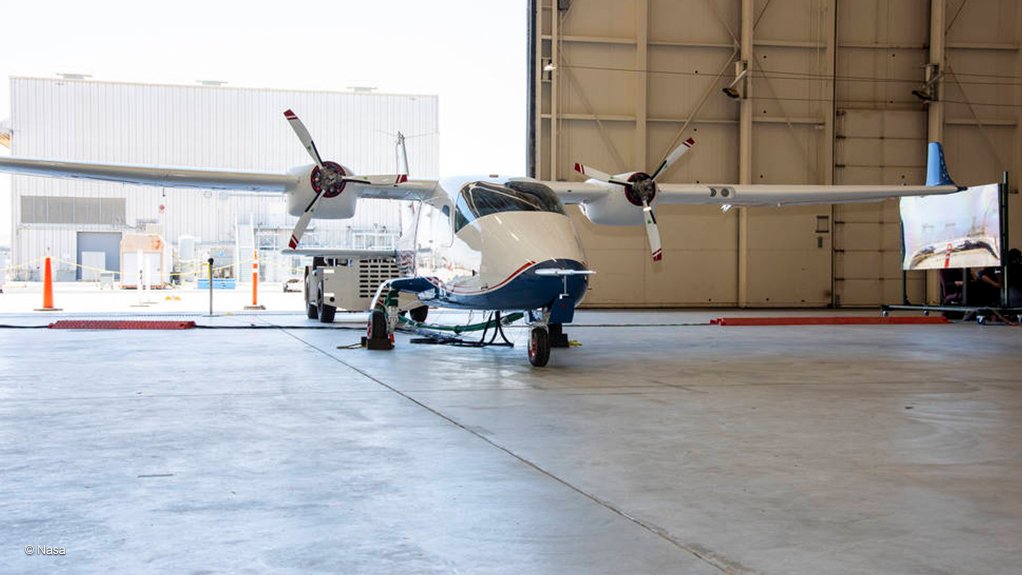Nasa reports key ground tests in its X-57 test plane were successfully concluded


The X-57 in its initial configuration; later, it will get a new wing
Photo by Nasa
The US National Aeronautics and Space Administration (Nasa) reported on Friday that a key stage had been successfully achieved in the pre-flight testing of its X-57 Maxwell experimental aircraft. This was the successful thermal testing of the cruise motor controllers for the aircraft’s all-electric propulsion system.
The X-57 is intended to demonstrate efficient and practical all-electric flight technologies, starting with the electric propulsion system on conventional wings but later combining electric power with a totally new wing design. (The X-57 has not been built from scratch but was a modified Italian Tecnam P2006T light twin piston engine aircraft.)
“The cruise motor controllers convert energy stored in the aircraft’s lithium-ion batteries to power the aircraft’s motors, which drive the propellors,” explained Nasa. “The controllers use silicon carbide transistors to deliver 98% efficiency during high-power take-off and cruise, meaning they do not generate excessive heat and can be cooled off by the air flowing through the motor.”
But while they may not themselves generate excessive heat, in flight the controllers would be exposed to extreme external temperature conditions. They were complex systems and some of their components were temperature-sensitive.
Consequently, the controllers which would be fitted to the X-57 recently underwent closely-monitored thermal testing inside a test chamber at Nasa’s Glenn Research Centre, in Cleveland, in the US state of Ohio. In the chamber, they were subjected to a wider temperature range than that which they would encounter in flight, to ensure a safety margin. Nasa gave the test temperature range in terms of degrees Fahrenheit (°F), still used in the US; it was -11 °F to +147 °F. This equivalated to -28.89 °C to +63.89 °C.
“Now that ground tests have validated the controllers under the most extreme temperature conditions expected in flight, the X-57 team is one step closer to integrating all of [the] Maxwell’s systems and ensuring that they can work together – one of the biggest challenges for an aircraft, especially a one-of-a-kind X-plane,” stated Nasa. The next important step in the X-57 programme was a Flight Readiness Review, an essential prerequisite for the authorisation of the aircraft’s first flight.
Comments
Press Office
Announcements
What's On
Subscribe to improve your user experience...
Option 1 (equivalent of R125 a month):
Receive a weekly copy of Creamer Media's Engineering News & Mining Weekly magazine
(print copy for those in South Africa and e-magazine for those outside of South Africa)
Receive daily email newsletters
Access to full search results
Access archive of magazine back copies
Access to Projects in Progress
Access to ONE Research Report of your choice in PDF format
Option 2 (equivalent of R375 a month):
All benefits from Option 1
PLUS
Access to Creamer Media's Research Channel Africa for ALL Research Reports, in PDF format, on various industrial and mining sectors
including Electricity; Water; Energy Transition; Hydrogen; Roads, Rail and Ports; Coal; Gold; Platinum; Battery Metals; etc.
Already a subscriber?
Forgotten your password?
Receive weekly copy of Creamer Media's Engineering News & Mining Weekly magazine (print copy for those in South Africa and e-magazine for those outside of South Africa)
➕
Recieve daily email newsletters
➕
Access to full search results
➕
Access archive of magazine back copies
➕
Access to Projects in Progress
➕
Access to ONE Research Report of your choice in PDF format
RESEARCH CHANNEL AFRICA
R4500 (equivalent of R375 a month)
SUBSCRIBEAll benefits from Option 1
➕
Access to Creamer Media's Research Channel Africa for ALL Research Reports on various industrial and mining sectors, in PDF format, including on:
Electricity
➕
Water
➕
Energy Transition
➕
Hydrogen
➕
Roads, Rail and Ports
➕
Coal
➕
Gold
➕
Platinum
➕
Battery Metals
➕
etc.
Receive all benefits from Option 1 or Option 2 delivered to numerous people at your company
➕
Multiple User names and Passwords for simultaneous log-ins
➕
Intranet integration access to all in your organisation



















